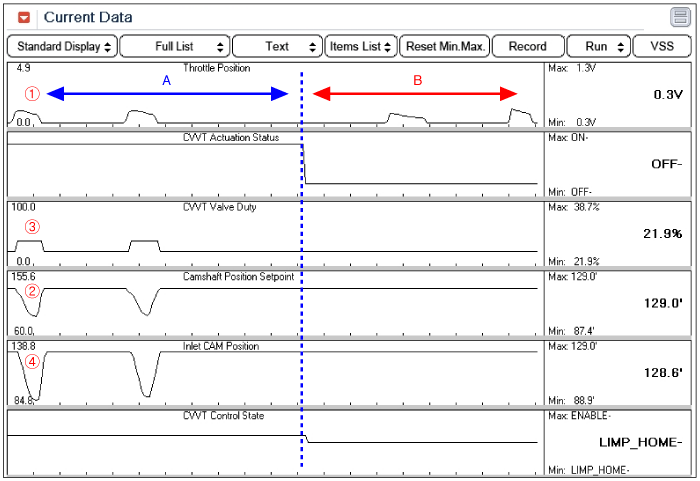After warming-up, check following items.


The CVVT (Continuously Variable Valve Timing) system is installed to the chain sprocket of the camshafts. This system controls the camshaft to provide optimal valve timing. The PCM controls the Oil Control Valve(OCV), based on the signals output from air flow, throttle position and engine coolant temperature. The CVVT controller regulates the camshaft angle using oil pressure through the OCV. As result, the relative position between the camshaft and the crankshaft becomes optimal, and the engine torque improves, fuel economy improves, exhaust emissions decrease under overall driving conditions.
The deviation of the camshaft position from the target point is evaluated during stable driving condition. The PCM accumulates this deviation for a certain period and sets DTC P0011 when the accumulated deviation is too high. The target camshaft position is predetermined value depending on engine speed and throttle angle in the PCM.
Item | Detecting Condition | Possible Cause | |
DTC Strategy | Case1 |
•
Deviation check between actual CAM position and CAM setpoint position in case of changing setpoint (slow response of actuator) | 1. Oil leak 2. Oil Control Valve 3. CVVT Assembly |
Case2 |
•
Deviation check between actual CAM position and CAM setpoint position (steady deviation) | ||
Enable Conditions | Case1 |
•
CVVT control active
•
Camshaft setpoint moving by more than 12°CRK within less than 0.70 sec.
•
Camshaft setpoint moved more than 5 times since engine start
•
11V < Battery voltage < 16V
•
600 to 1500< Engine speed(RPM) < 5000
•
No relevant failure
•
20℃(68℉) < Engine oil temp. < 110℃(230℉) | |
Case2 |
•
CVVT control active
•
Camshaft setpoint moved more than 5 times since engine start
•
Camshaft setpoint not close to full retard position
•
11V < Battery voltage < 16V
•
600 to 1500 < Engine speed(RPM) < 5000
•
No relevant failure
•
20℃(68℉) < Engine oil temp. < 110℃(230℉) | ||
Threshold Value | Case1 |
•
CAM position movement < 3.4 °CRK within 0.8 sec. (with CAM setpoint moving by 12 °CRK) | |
Case2 |
•
Integral of Camshaft position actual value - Camshaft position setpoint > 45°CRK/sec. | ||
Diagnostic Time | Case1 |
•
600 sec. | |
Case2 |
•
180 sec. | ||
MIL On Condition |
•
2 Driving Cycles | ||
Intake OCV | Normal Parameter |
Insulation Resistance (Ω) | Above 50 ㏁ |
Temp.(℃) | Temp.(℉) | Resistance(Ω) | Temp.(℃) | Temp.(℉) | Resistance(Ω) |
0 | 32 | 6.2 ~ 7.4 | 60 | 140 | 8.0 ~ 9.2 |
10 | 50 | 6.5 ~ 7.7 | 70 | 158 | 8.3 ~ 9.5 |
20 | 68 | 6.9 ~ 7.9 | 80 | 176 | 8.6 ~ 9.8 |
30 | 86 | 7.1 ~ 8.3 | 90 | 194 | 8.9 ~ 10.1 |
40 | 104 | 7.4 ~ 8.6 | 100 | 212 | 9.2 ~ 10.4 |
50 | 122 | 7.7 ~ 8.9 |
Connect GDS and select Data Analysis.
After warming-up, check following items.

Data analysis
▶ A Sector : CVVT works
▶ B Sector : Limp Home Mode (CVVT doesn't work.)
▶ CVVT Control Flow (A Sector)
: Acceleration pedal(①) shift → Engine RPM change → Camshaft Position Setpoint (②) change → CVVT Valve Duty(③) change → Inlet CAM Position(④) change